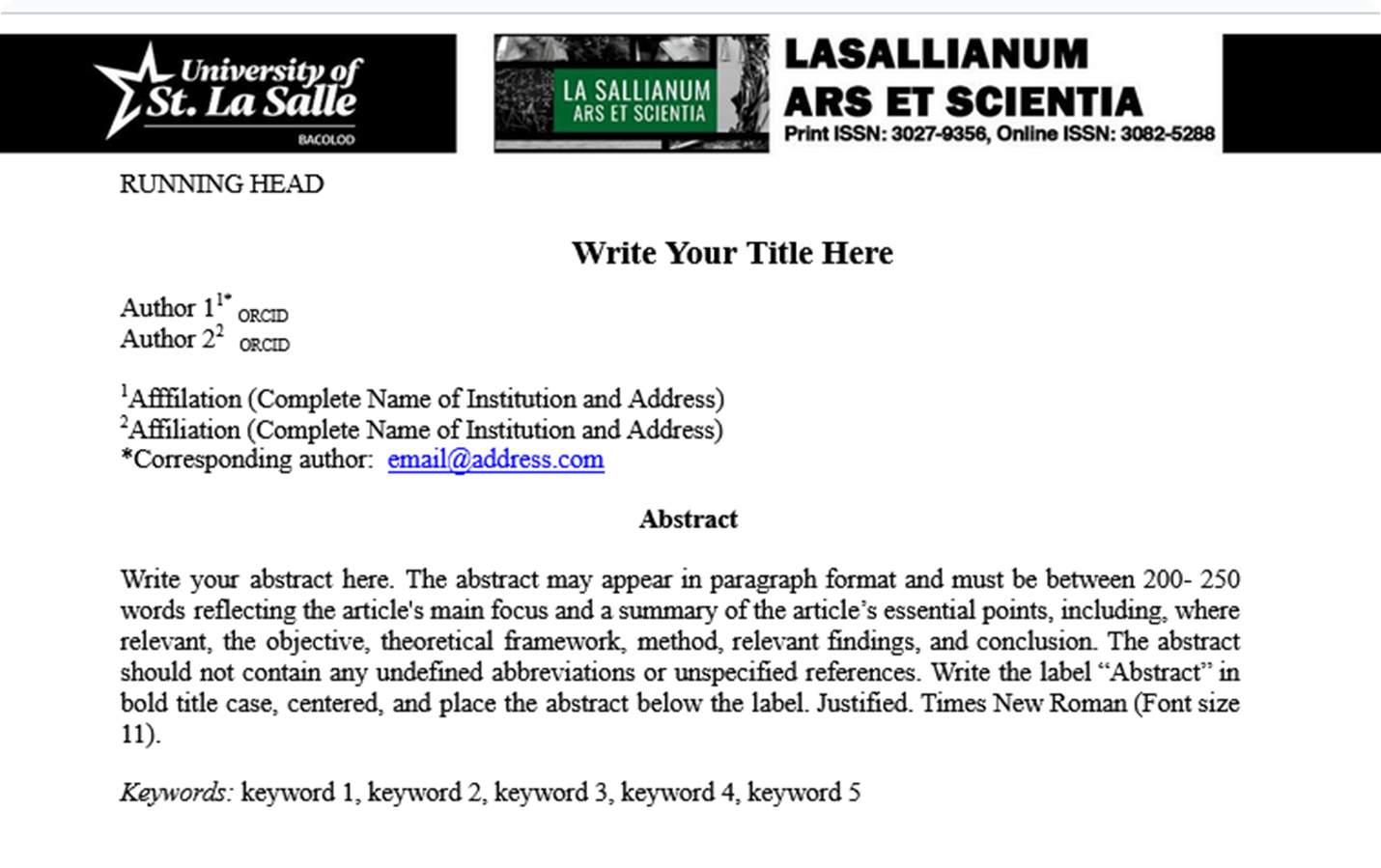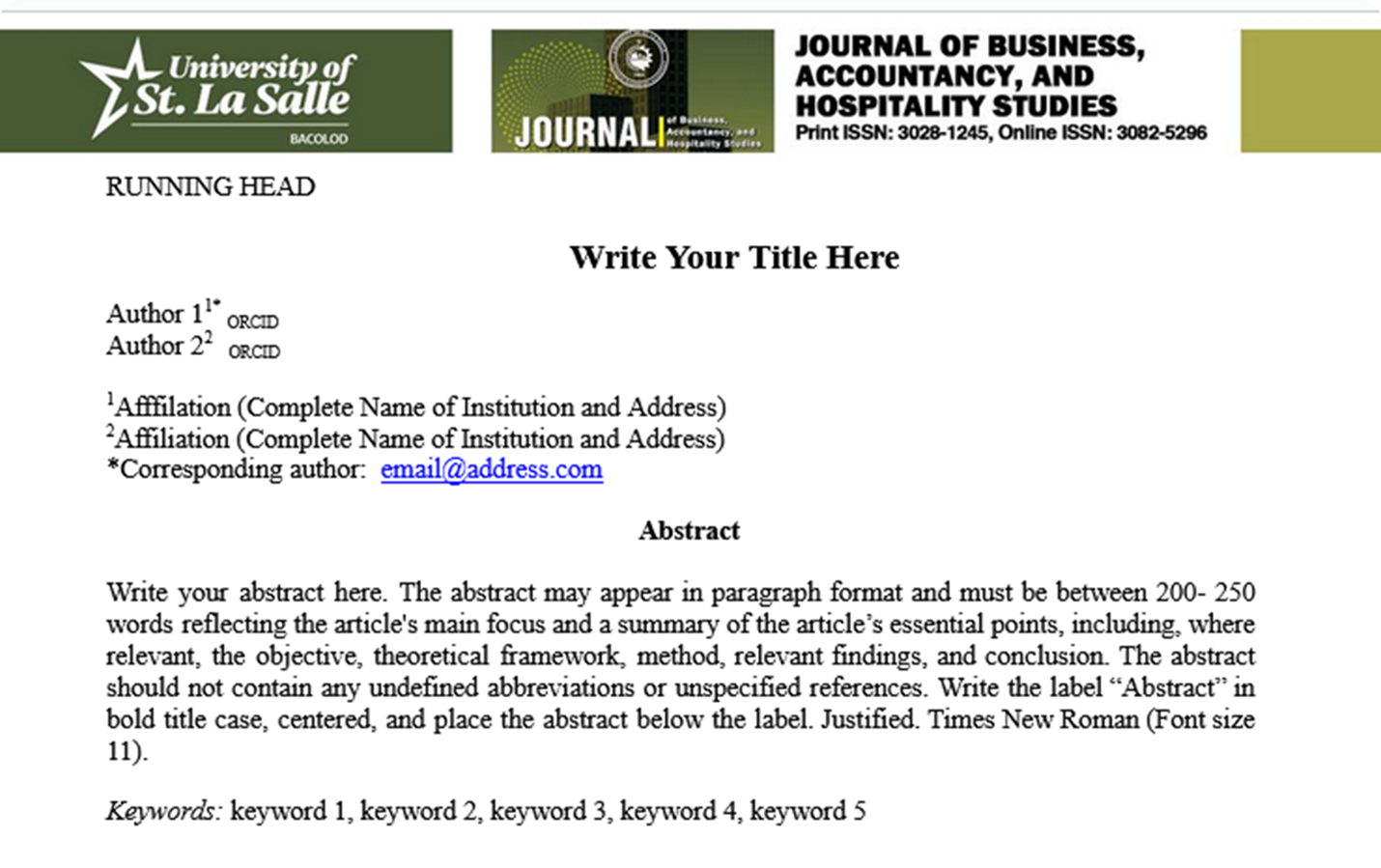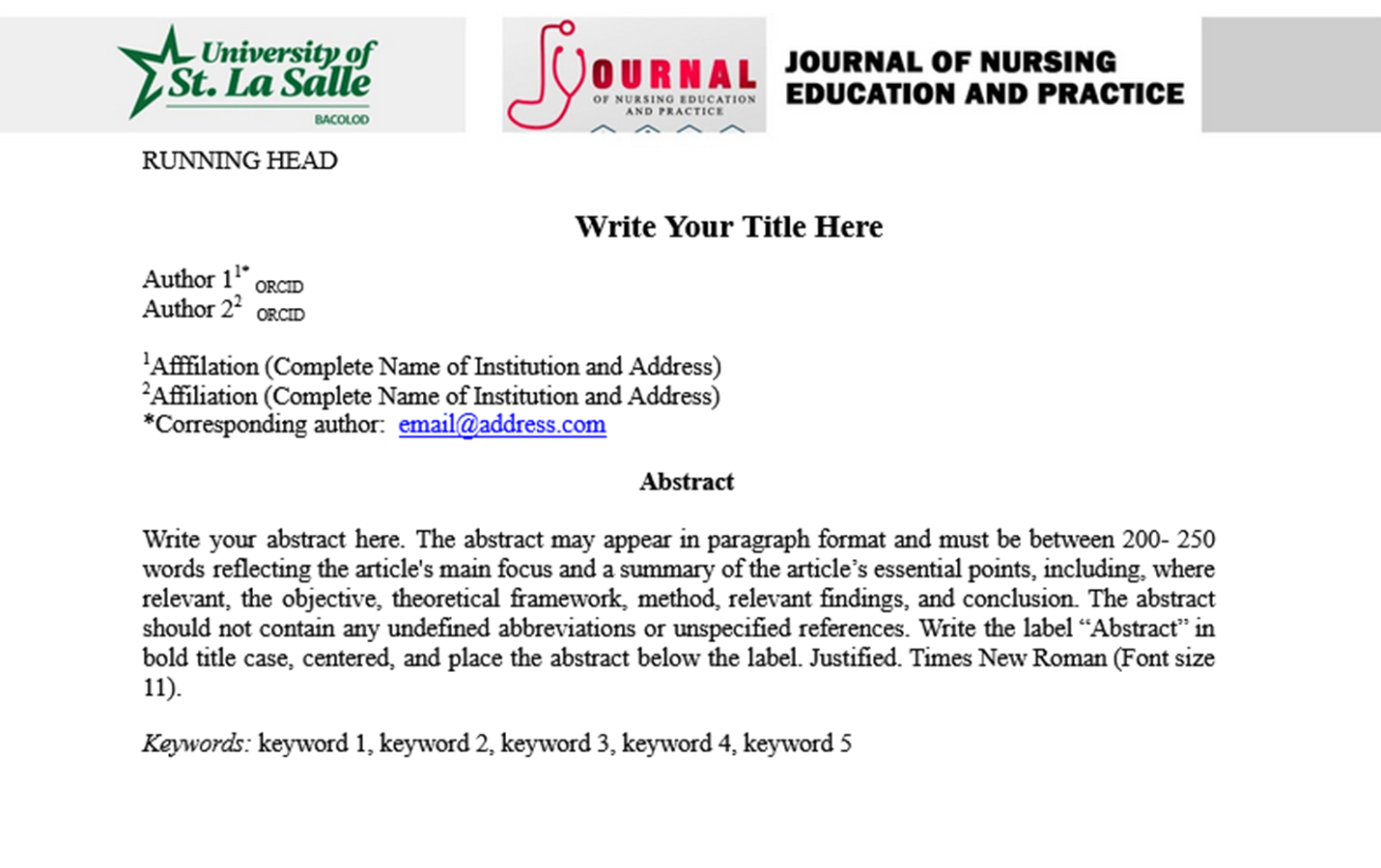b. A brief biographical information of at most 100 words ( bionote ) with a 2×2 photo in JPEG format (high resolution) of every author must be provided.
2. Send the manuscript to peo@usls.edu.ph or upload it along with pertinent PEO forms to Publication and Engagement Office Form for In-House or External Journal Publications
3. The manuscript should:
a. be in MS Word document format;
b. text be justified, single-spaced paragraphs, with the first line of each paragraph indented by one tab key. The text should include the abstract, keywords, main body, acknowledgments, AI-declaration, author note, tables, references, and appendices
c. use Times New Roman, size 11;
d. have a one-inch margin on all sides (The text is fully justified or aligned to both the left and the right margins.);
e. have the Running Head in the page header, flush left, in all capital letters. Authors are requested to use the running head on every page, including the title page; do not include the label “Running head”;
f. have pages consecutively numbered (bottom right);
g. have the first line of each paragraph indented, except for the first line of the text in each section and subsection;
h. have all sections and subsections in title case, in bold;
i. use standard or canonical forms for tables, include all basic components of a prototypical table or whichever applies to your manuscript; titles of tables and figures must be in sentence case and italicized; limit the use of borders or lines in a table; see section --- in the style guide for sample tables
j. sections/subsections should be numbered 1., 2. (then 1.1, 1.1.1, 1.1.2), 1.2, etc. Section numbering does not include the abstract, declaration of generative AI and AI-assisted technologies, author notes, acknowledgments, and references in the writing process.
l. references should follow the APA 7th edition format
m. research article (4,000 to 8,000 words) excluding abstract and references
a) Introduction: The introduction should be brief. Make sure that the following basic rhetorical moves are included in this section: (1) establish a research territory; (2) identify a gap; (3) occupy the niche (stating the purpose). At least present the purpose(s) of the study and provide a niche for your work.
b) Method: The method section should describe the subjects, procedures, instruments, and design. Each of these should be presented under a heading of its own. The instruments (questionnaires, tests, and the like) should be shown in the appendices section at the end of the manuscript. Provide sufficient details to allow the context of the work to be thoroughly understood by readers, i.e., clearly describe the context and participants or subjects along with strategies used to gather and analyze data. Evidence of the reliability and validity of the instruments used should also be presented.
c) Results/ Findings and Discussion: In discussing the results or findings of the study, the author should explore the significance of the results of their work. By citing relevant literature, they should show in this section how the study connects with or deviates from the already published body of existing literature.
d) Conclusion: The main findings should be clear and concise. The conclusion section can include suggestions and recommendations based on the research findings as well as the pedagogical implications of the study (if applicable).
e. Declaration of Generative AI and AI- AI-assisted technologies in the writing process. The authors are responsible for declaring an itemized use of Generative AI and AI- assisted technologies in the writing process. This declaration does not apply to basic tools for checking grammar, spelling, references, etc. If AI tools are not used in any part/section of the manuscript, state your non-disclosure.
Sample Template: During the preparation of this work, the author(s) used [NAME TOOL / SERVICE] to [REASON] in [SECTION/COMPONENTS]. After using this tool/service, the author(s) reviewed and edited the content as needed and should take full responsibility for the publication's content.
f. Author Note. The authors are responsible for providing additional information about the authors, study registration, data sharing, and recognizing and disclosing financial and other conflicts of interest that might bias their work. They should acknowledge in the manuscript all financial support for the job and other financial or personal connections to the work. Suppose there are no such conflicts or financial support to acknowledge. In that case, the authors should declare this by the following statement: The authors confirm that no known conflicts of interest are associated with this publication. There has been no significant financial support for this work that could have influenced its outcome.
g. Acknowledgements. The authors are responsible for including all names of contributors who do not meet the criteria for authorship, such as a person who provided purely technical help, writing assistance, or a department chair who provided only general support, should be listed in the acknowledgments. Financial and material support should also be recognized in the acknowledgments.
h. References: The author is responsible for ensuring that the information in each reference entry is complete and accurate. Where applicable, author name, journal title/ book title, article title, year of publication, volume number, book chapter or article number, or pagination must be available. All quoted or cited sources (primary or secondary) in the manuscript should be appropriately referenced; hence, there should be a one-to-one correspondence between the cited or quoted sources and those found in the reference list.
Format of the Reference List:
•Place the section label “References” in bold, flush left, unnumbered.
•Order the reference list entries alphabetically by author.
•Single-space the entire reference list ( both within and between entries).
•Apply a hanging indent of 1 tab to each reference list entry (the first line of the reference is flush left, and subsequent lines are indented one tab from the left margin). Use the paragraph-formatting function of your word- processing program to apply the hanging indent.
6. The APA Citation Style 7th Edition should be used in writing references and citations, including punctuations and abbreviations, table construction, headings selection, and statistics presentation. Subsections should be numbered 1., 2. (then 1.1, 1.1.1, 1.1.2), 1.2, etc. Section numbering does not include the abstract, declaration of generative AI and AI- assisted technologies, author notes, acknowledgments, and references in the writing process.
7. Figures, if provided, should be clear and in JPEG format (high resolution).
8. Tables that are part of the main text (i.e., not part of an appendix or supplemental materials) must be numbered using Arabic numerals, for example, Table 1, Table 2, and Table 3. Assign the numbers in the order in which each table is first mentioned in the text. Write the word “Table” and the number in bold and flush left.
9. The manuscript should be an original work, has not been published elsewhere, is not currently being reviewed, and will not be submitted to another journal while it is being considered for publication by any USLS In-House Journals or USLS Journal of Higher Education Research.
10. The copyright of a manuscript published by the journal remains with its author/s. The author/s should also sign a copyright-agreement form upon the formal acceptance of the paper. The author/s should also be responsible for obtaining permission to reproduce any figures, illustrations, tables, and the like from other publishers and properly acknowledge other authors’ work.
11. All submissions will undergo a double-blind review. The review process includes the following:
a) initial Turnitin and Grammarly scans are done upon submission of the manuscript, 10% and below Similarity Index Result; 95% Grammarly General Score
b) initial screening for adherence to submission guidelines 1-4;
c) review of manuscripts by the editorial board;
d) revision of potential papers by authors based on comments/suggestions of the editorial board;
e) sending of approved revised papers for peer review of the external advisory board;
f) review, issuance of reports, evaluation, and recommendations by external experts; and
g) sending of reviews of experts to authors. Papers recommended for publication need to be revised based on comments/suggestions;
h) final Turnitin scanning (consistency of 10% and below Similarity Index Result) and Grammarly ( consistency of 95% score);
i) technical grammar editing
j) manuscript layout
k) copy/proofreading
l) galley proofreading of author/s
m) printing/distribution
12. The author/s will receive the review results in 16 – 24 working weeks upon submission of the paper.
13. All correspondence, including editor’s decisions, requests for revisions, and external referees’ comments and suggestions, is sent through email (peo@usls.edu.ph) or the corresponding journal email
SAMPLE AUTHOR STYLE GUIDE:
| Journal of Higher Education Research (Institutional Journal) |
Lasallianum Ars et Scientia (College of Arts and Sciences) |
 |
 |
| Journal of Engineering, Food Science and Computing Technologies (College of Engineering and Technology) |
Journal of Business, Accountancy, and Hospitality Studies (Yu An Log College of Business and Accountancy) |
 |
 |
| Breakthroughs: A Research Journal of Learning and Instruction (College of Education) |
Journal of Nursing Education and Practice (College of Nursing) |
 |
 |


